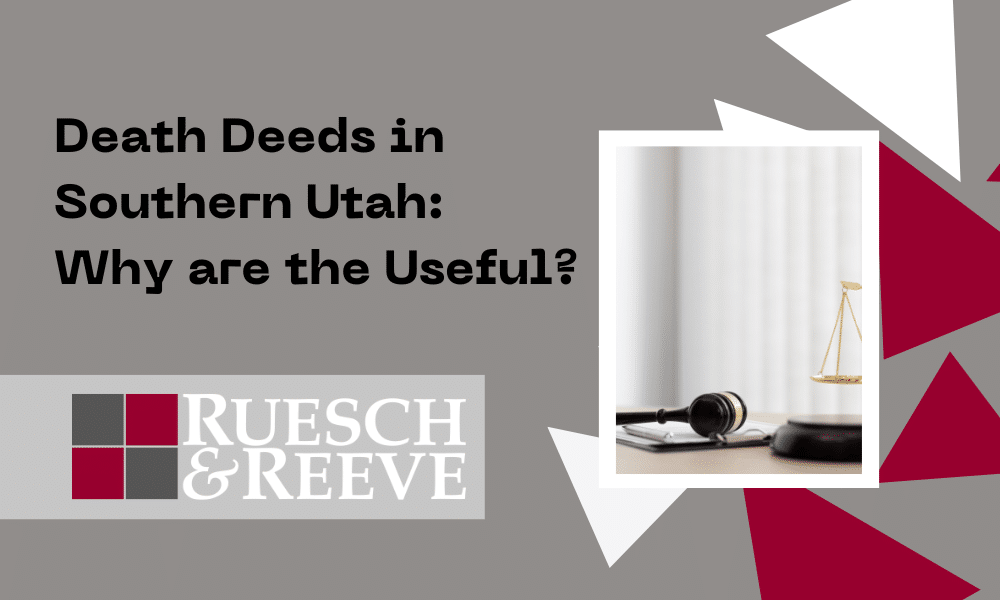A transfer on death deed (TOD) is an option for an individual to pass along their property to designated individuals upon their death without requiring them to go through the probate process, which can be long and expensive. A TOD deed is also known as a beneficiary deed or revocable transfer on death deed. Ruesch & Reeve is available to assist in the process of filing death deeds in Southern Utah.
Ruesch & Reeve is a law firm located in southern Utah that provides residents with assistance in estate planning, and the firm wants to start offering a death deed in southern Utah because it’s an important and useful document. Utah passed a law in 2018 to allow people to use TOD deeds in their estate planning. If you live outside of Utah, double-check to make sure if your state allows this kind of document while setting up your estate plan.
As of the end of 2019, the following states allow some form of TOD deed: Arizona, Alaska, Colorado, California, Hawaii, Indiana, Illinois, Maine, Kansas, Missouri, Montana, Minnesota, Nevada, Nebraska, North Dakota, Oklahoma, New Mexico, Oregon, South Dakota, Utah, Texas, Virginia, Washington, Wisconsin, West Virginia and Wyoming.
What is a Death Deed?

A TOD deed is also known as a death deed. A death deed is used to transfer property following the death of an individual. By signing a death deed, an owner can determine who they wish to transfer their property to once they pass. The wishes in the death deed does not take effect until the death of the owner, to which the designated grantee named in the death deed is transferred automatically.
If married couples hold a deed, most states will automatically designate the surviving spouse as the sole owner. The beneficiary of a death deed does not take ownership until the surviving spouse passes, but there is a chance that the surviving spouse can decide to revoke the death deed at any time before they pass.
An individual can name more than one beneficiary in their death deed if they wish to. The individual should indicate how they take the title, either “as joint tenants with rights of survivorship” or “as tenants in common.” They may also designate alternative beneficiaries in case the original one dies.
Why is it useful?
The process to transfer a death deed is simple and easy. The owner can revoke or replace the document any time before they pass away, and it doesn’t take effect until their death. Once the owner dies, the beneficiaries will need to submit the owner’s death certificate and an affidavit to the county where the property is located, and they become the new owners.
The following are benefits of a TOD deed opposed to other methods of transferring property upon death:
- A TOD deed maintains homestead advantages. Certain types of ownership transfers may lose the asset protection and taxation benefits for a person’s principal residence, but the TOD deed does not.
- Saves on taxes. Designating a beneficiary is not an immediate transfer, so they won’t owe a federal gift tax.
- Bypasses the probate process. Unlike a simple will that still requires the property to go through the probate process, a TOD deed avoids it. Naming someone on the deed as a joint owner with rights of survivorship will also avoid the probate process.
- A simple document. An alternative method to avoid probate is to transfer property into a living trust, but it can be more complicated than a TOD deed. Large estates with several properties and/or beneficiaries will benefit more from a living trust, though.
Why do you want to avoid the probate process?
It is preferable to avoid the probate process because it can be long and expensive. Real estate that is not owned or held in any special way is considered “probate property.” For example, someone owns a house without any special forms of ownership or special arrangements. When the owner dies, the house must go through the probate process before transferring to the beneficiaries. To keep the property out of the probate process, the owner must turn it into a “non-probate property” by using a transfer on death deed.
What is the probate process?
The probate process takes place after someone dies and their estate is distributed according to what is outlined in the will. The process also includes paying debts the deceased person owed and settling assets.
What are the steps in the probate process?
- File the petition
Following the death of an owner, someone will file a petition with the court to open probate for the estate under that individual’s name. Additionally, they need to include a copy of the death certificate and will. Once the court has reviewed the information, the probate is opened. This is also when the executor is appointed.
The will should include the name of who was chosen as the executor, but if no one is named, the court can appoint the beneficiary or any heirs that wish to take on the task. If they still don’t have an executor from the family, the court will choose an attorney or accountant for the estate to take on the executor role.
- Issue bond
The executor will need to issue a probate bond that protects them from any claims of fraudulent activity. The bond covers all the work they do on behalf of the estate such as paying bills and selling assets. If by chance they do make a mistake that costs money to the estate, the probate bond will cover it.
- Notice to creditors
The first job of the executor is to give notice to creditors either by publishing a notice in the local newspaper or sending a letter to the known creditors. This process may vary by state. The timeframe to submit the claims to be paid can vary by state, but averages from three to four months.
- Take inventory
The executor is in charge of taking inventory of the assets owned by the deceased. The length of time this will take depends on how large the estate is. This process can also take longer if the deceased owned a business because it will need to be closed to allow for liquidation.
- Pay estate taxes
The executor will then need to file personal or business tax returns and pay any amounts owed, if necessary. This must be completed before the estate can be distributed to ensure the returns are approved with no changes needed.
- Final petition for final distribution
The executor will then distribute the rest of the estate to the heirs named in the will. It can be as simple as issuing funds to each person, or it can be more complicated if real estate property is given to someone. In that case, the title would be transferred to the new owner, which the executor will oversee.
How long does the Probate process take?
The probate process can take anywhere from a few months to several years to complete. The length is determined by the size of the estate, how long it takes to take inventory, the time it takes for creditors to submit a claim for estate money that is owed, and if any assets need to be sold to pay creditors.
As you can see, the probate process can be a hassle, and if possible, you will want to avoid it. This is why it will be important for those who live locally to talk with Ruesch & Reeve about filing a death deed in southern Utah.
How much does Probate cost?
One of the downsides of the probate process is its cost, and it can vary depending on the state you live in, the size of the estate, how complicated your estate plan is, and whether or not someone is opposed to any part of your plan. The fees will not come out of anyone’s pocket, but they will come out of the estate money, taking away from what the beneficiaries will receive in the end.
- Attorney and accounting fees
People may feel more comfortable navigating the probate process with an attorney alongside them, and some states require you to hire one. The fee for a lawyer will vary depending on their hourly charge or if the state allows them to charge a fee based on the client’s estate value.
- Court fees
The probate court does not have one flat fee, so it will depend on the individual county and state filing fees. The common fees you should expect to pay along the way include:
- Filing fee – The initial fee you will pay to begin the process (ranges from $50-$1,200)
- Certificate fee – You’ll be asked to submit certificates such as Letters of Testamentary or Administration, which authorize an executor to act on the behalf of the deceased. The certificates can range from $5-20 per certificate.
- Notifications – part of settling an estate is notifying the beneficiaries and heirs, which can range from $10-$300 per notification.
- Miscellaneous fees
Some other fees you may come across are appraisal fees, postage fees, business valuation fees, notary fees, storage fees, and estate sale prep fees.
How do you create a TOD deed?
The requirements for a TOD deed vary between state to state. In Utah, a TOD deed has three requirements: 1) contains the elements required for a regular deed; 2) state that the transfer is to occur at the owner’s death; and 3) be recorded before the owner’s death at the county recorder’s office where the property is located. The document must comply with these rules by including certain information such as the names of the current owner and beneficiary, the beneficiary’s signature, a description of the property, and witness and notary provisions. The document will also need to include minimum type size and formatting to allow space for recording stamps.
The TOD deed document must also clearly state the name of the beneficiary, who is usually referred to as the “grantee beneficiary,” and that the transfer will take place upon the death of the current owner.
Once the document is created, the owner must take it to the county public records office to be recorded in the county where the property is located. This will cost a small fee. The records clerk will indicate the date it was received, have it officially entered into their records, and return the original to the owner.
If, by chance, you want to revoke a TOD deed that has already been recorded, Utah provides three options. First, you can complete and sign a revocation form and record it in the county where the property is located. Second, you can create a new TOD deed with new beneficiaries for that particular property and record it in the appropriate county recorder’s office. Finally, you can transfer the property using a normal deed that expressly revokes the TOD deed. A TOD deed cannot be revoked in a will; you need to use one of these options if you want to revoke a TOD deed.
Preparing a death deed in southern Utah is a simple process that will benefit the owners of the property and their heirs. What comes after the death of a loved one should be the least stressful as possible, so choosing to avoid the probate process and have the property transferred to the new owner by filing a death deed in southern Utah will be the best choice for everyone.

